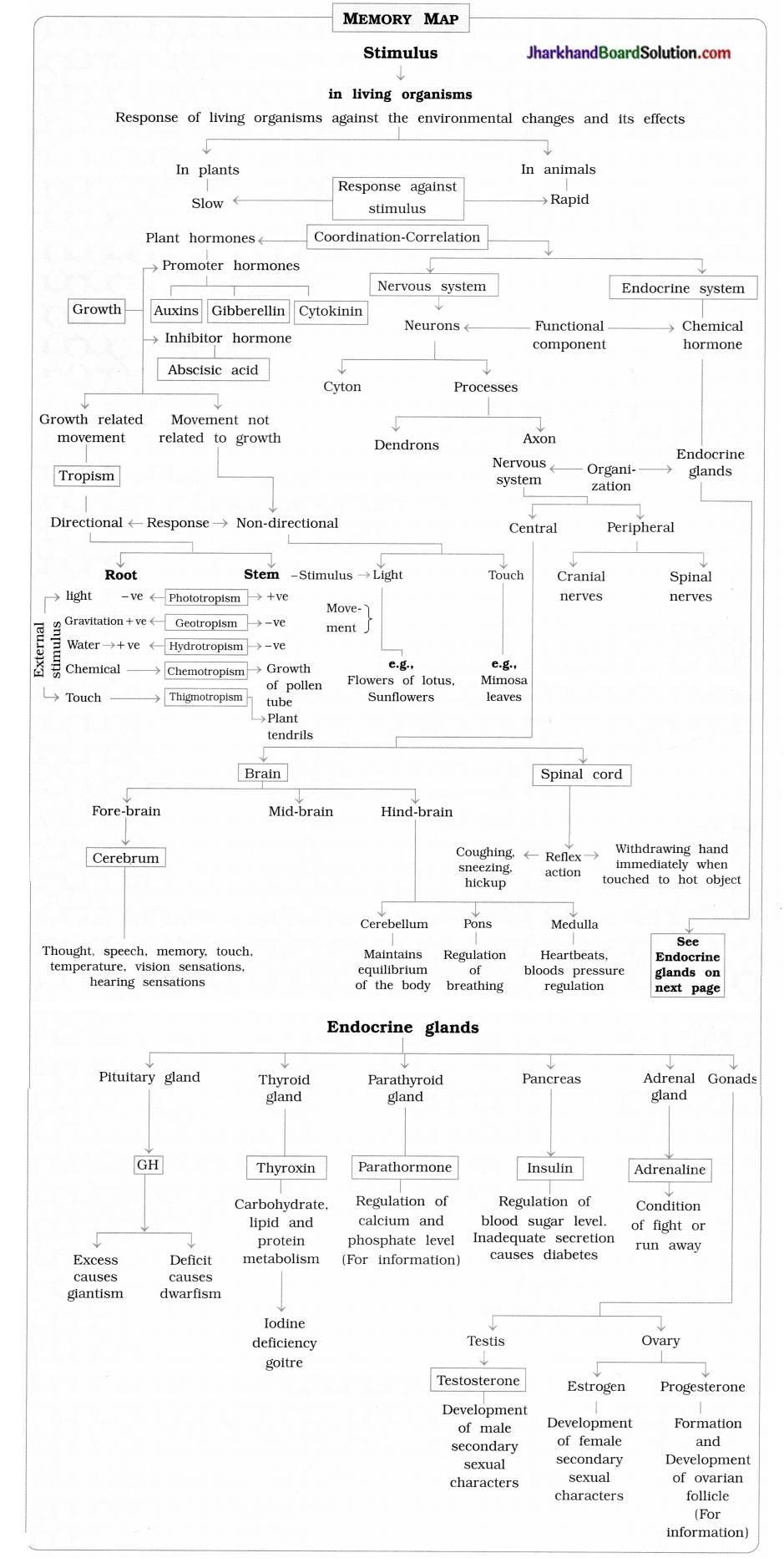Jharkhand Board JAC Class 10 Science Important Questions Chapter 7 Control and Coordination Important Questions and Answers.
JAC Board Class 10 Science Important Questions Chapter 7 Control and Coordination
Additional Questions and Answers
Question 1.
Distinguish between :
(1) Response in Plants and Response in Animals
Answer:
| Response in Plants | Response in Animals |
| 1. Plants do not possess nervous system but only possess hormones for expressing their response. | 1. Animals possess both, the nervous system and endocrine system for expressing their response. |
| 2. The response in plants is not rapid and needs more time to be observed. | 2. The response in animals is rapid and seen immediately. |
| 3. The response in plants is limited. | 3. The response in animals is not limited. |
| 4. There are no muscular tissues in plants to show the response. | 4. There are muscular tissues in animals through which the response is shown. |
| 5. In plants, there is no specific tissue for the transmission of information to different parts of the body. | 5. In animals there is specific nervous tissue for the transmission of information to different parts of the body. |
(2) Nervous System and Endocrinal System
Answer:
| Nervous System | Endocrinal System |
| 1. Its structural and functional unit is a neuron (nerve cell). | 1. Its functional unit is a hormone. |
| 2. In human body it comprises central nervous system, peripheral nervous system and autonomous nervous system. | 2. In human body it comprises of various endocrine glands. |
| 3. Its function is to collect the information, its analysis and interpretation and convey the responsive message to the motor organs. | 3. Its function is to produce stimulatory or inhibitory effect on the tissues or organs through the medium of hormones. |
| 4. The coordination that occurs through the nervous system is very rapid as the impulses pass through the nerve fibres. | 4. The coordination that occurs through the endocrine system is a relatively slow process as the hormone flows through the blood stream to reach the target organ. |
![]()
(3) Cerebrum and Cerebellum
Answer:
| Cerebrum | Cerebellum |
| 1. It is a major part of the fore-brain. | 1. It is a part of the hind-brain. |
| 2. It coordinates thoughts and various other senses. | 2. It coordinates the functions of voluntary muscles and thereby maintains the body equilibrium. |
| 3. It is the largest and most complex part of the brain. | 3. It is a part lying behind the cerebrum, on the dorsal side beneath the pons. |
(4) Plant hormones and Animal hormones
Answer:
| Plant hormones | Animal hormones |
| 1. Plant hormones are secreted by plant cells but no specific glands are there. | 1. Animal hormones are secreted from endocrine glands. |
| 2. Plant hormones are either growth promoting or growth inhibiting. | 2. There is no inhibitor hormone for growth in animals. |
| 3. Plant hormones reach to their target site by simple diffusion. | 3. Animal hormones reach to their target site through blood circulation. |
| 4. Secretion of it is not regulated by feedback mechanism. | 4. Secretion of some hormones regulated by feedback mechanism. |
Question 2.
Give scientific reasons for the following statements:
(1) Response to stimuli is the characteristic of every living organism.
Answer:
All living organisms experience the effects of changes in the atmosphere that surrounds them and tend to respond differently against them.
The living organisms show a slow or rapid response to stimuli such as heat, cold, sound, touch, pressure, etc. Responses are expressed against these stimuli through hormones in plants and nervous system as well as hormones in animals, e.g., The plants bend in the direction of light. Man shows shivering effect in severe cold and perspiration in hot season.
Thus, the response to stimuli is the characteristic of every living organisms.
(2) Unlike animals, the plants do not show immediate response.
Answer:
All organisms show response to stimuli. However, the animals possess nervous system and s sense organs, which are absent in plants. Animals use the nervous system as well as endocrine system for control and coordination of all their activities, while the plants possess only hormones to coordinate their activities. The hormones diffuse from cell to cell quite slowly in plants while most animals have blood for rapid transport of hormones. Because of all these reasons, the plants do not show immediate response.
(3) The roots in plants grow against the direction of light.
Answer:
The roots in plants show positive tropic movement in the direction of water and gravitational force, i.e., The roots show positive hydrotropism and positive geotropism.
Thus, the roots bend in the direction Thus, the roots bend in the direction of water and gravitational force. So it grows against the direction of light.
(4) The central nervous system is very well protected.
Answer:
The central nervous system comprises of a brain and a spinal cord.
Brain is contained in a fluid-filled balloon which absorbs mechanical shocks and thereby protect it from any severe injuries. Moreover, the brain is enclosed in a strong bony box – the cranium of the skull and the spinal cord is enclosed in a long and strong bony vertebral column. Thus, the central nervous system (of the human) is very well protected.
(5) The foot is very suddenly lifted off as soon as it comes in contact with a burning coal.
Answer:
It is a reflex action – In this phenomenon, the impulse commencing from the sensory organ (the skin of the foot) enters into the spinal cord through the sensory nerve fibres. The impulse is analysed in the spinal cord and the responsive motor impulse is transmitted through the motor nerve fibres to the effector organ (the foot muscles) to contract and thereby show the response. Sp the foot is very suddenly lifted off as soon as it comes in contact with a burning coal.
(6) The hormones secreted from the endocrine glands are present everywhere in the body.
Answer:
The hormones are secreted from the endocrine glands which are ductless glands. These glands are richly supplied with blood. The secretions are directly poured in the blood stream. As the blood circulates in all the parts of the body, these hormones are carried and hence present everywhere in the body.
(7) The diabetic patient is given injections of insulin.
Answer:
It is necessary to maintain a definite blood sugar level in the human body. In the patients of diabetes the blood sugar level remains high due to the deficiency of insulin hormone from the pancreas. This higher blood sugar level causes several harmful effects.
To prevent the diabetic patient from such harmful effects the blood sugar level is required to be maintained at certain definite level. Insulin is a hormone that reduces blood sugar level. Hence, the diabetic patient is given injections of insulin.
![]()
(8) It is advisable to take iodized salt in daily food.
Answer:
The hormone thyroxin is secreted from the thyroid gland. It is an iodized hormone (rich in iodine). Thyroxin is not formed when there is deficiency of iodine in the blood. As a result, the condition called hypothyrodism occurs in which the size of the thyroid gland gets gradually enlarged, this disease is called goitre. The iodized table salt provides proper amount of iodine for the formation of thyroxin in the thyroid gland.
Hence, it is advisable to take iodized salt in daily food.
Question 3.
Carefully observe the given diagram id answer the questions related with it:
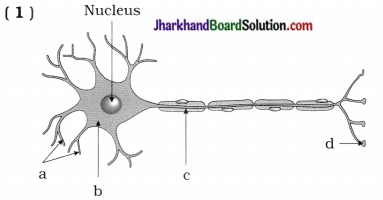
Questions :
- Identify ‘a’ and state the function of it.
- At which region in diagram chemicals are released?
- Identify ‘c’ and state from which it originates.
Answer:
- a – Dendrite.
Function: Information received at the end of its tip. - At d – region (nerve ending) in diagram chemicals are released.
- c – Axon. It originates from cell body.
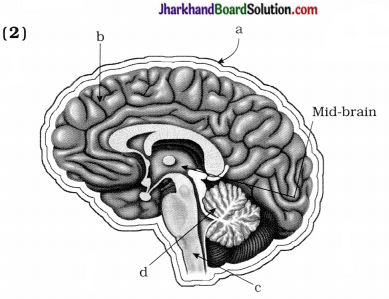
Questions :
- Identify ‘a and state its function.
- Where is information stored in brain? Mention its alphabet.
- State any two functions of part ‘d’
- Identify ‘c’ State the name of special structure formed by it which show quick response.
Answer:
- a-Cranium (bony box).
Function : It protects brain. - b – Cerebrum
- d – Cerebellum. It is responsible for precision of voluntary actions and maintaining the posture and balance of the body.
- c – Spinal cord. For quick response, the reflex arc is formed by it.
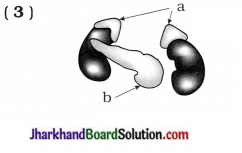
Questions:
(1) State the name of ‘a’ and ‘b’ with location.
(2) State any two functions of ‘b’
(3) In which condition, ‘a’ is stimulated and give the name of its secretion.
Answer:
(1)
| Name | Location |
| a. Adrenal gland | At the anterior of kidneys |
| b. Pancreas | Under the stomach in abdomen |
(2) Functions of ‘b’ (Pancreas) : Secretes insulin and regulates blood sugar level. Secretes pancreatic juice and help in digestion.
(3) In a fear or tense condition ‘a’ (adrenal gland) is stimulated and secretes adrenaline hormone.
Objective Questions and Answers
Question 1.
Answer the following questions in short:
(1) Name the two systems of control and coordination in higher animals.
Answer:
The nervous system and the endocrine system are the two systems of control and coordination in higher animals.
(2) Name the three components of a nerve cell.
Answer:
The three components of a nerve cell s are a cyton, an axon and one or more dendrons.
(3) Name the most important part of the s human brain.
Answer:
The most important part of the human brain is cerebrum which is the largest part of the brain.
(4) State one function of cerebellum.
Answer:
| Part | Function |
| Cerebellum | Coordination of movement of the and maintenance of body equilibrium. |
(5) Give the function of medulla.
Answer:
Function of medulla: It maintains the rhythm of various involuntary processess such as breathing, heartbeats, peristalsis of the alimentary s canal, etc.
(6) Name the structural and functional unit of nervous system.
Answer:
The neuron (nerve cell) is the structural and functional unit of nervous system.
(7) Name one hormone secreted by the pituitary gland.
Answer:
One of the hormones secreted by the pituitary gland is GH (Growth Hormone).
(8) Give example of the movement of a plant part which is caused by the loss of water.
Answer:
Sensitive plant: Touch-me-not (Mimosa ( pudica).
(9) What is the response of roots to gravity? What is this phenomenon known as?
Answer:
A root give positive response to gravity, this phenomenon is called positive geotropism.
(10) What is the response of stem to light? What is this phenomenon known as?
Answer:
A stem moves towards light. This phenomenon is known as positive phototropism.
(11) What is an impulse?
Answer:
Information that is transmitted through the nerves in form of electro-chemical signals are called impulse.
(12) What is gustatory receptors? Where they located?
Answer:
The receptors which detect taste are called gustatory receptors. They are located on the surface of tongue.
![]()
(13) By what is nervous tissue made-up of? What is its special ability?
Answer:
The nervous tissue is made-up of an organised network of neurons. It is specialised for conducting information via electrical impulses.
(14) State any two examples of movement in order to protect ourselves.
Answer:
When bright light is focussed on eyes, we constrict pupils, we pull our hand when we touch a hot object. These are the examples of movement in order to protect ourselves.
(15) What are components of peripheral nervous system?
Answer:
The peripheral nervous system consists of cranial nerves arising from brain and spinal nerves arising from the spinal cord.
(16) Which separate areas are there in fore brain?
Answer:
There are separate areas specialised for hearing, smell, sight, etc. in fore-brain.
(17) Why thinking is called a complex activity?
Answer:
Thinking is called a complex activity, because it is bound to involve a complicated interaction of many nerve impulses from many, neurons.
(18) How do we know that we have eaten enough?
Answer:
The sensation of feeling full is because of a centre that is associated with hunger, located in separate part of the fore-brain.
(19) Which involuntary actions are controlled by medulla in the hind-brain?
Answer:
Involuntary actions such as blood pressure, salivation, vomiting are controlled by medulla in the hind-brain.
(20) How do animal muscles move?
Answer:
When a nerve impulse reaches the muscle, the muscle fibre can move due to stimulation.
(21) How does a muscle cell move?
Answer:
Muscle cells move by changing their shape either shortening or elongating.
(22) How do muscle cells change their shape?
Answer:
Muscle cells have special proteins that change both their shape and arrangement in cells, so muscle cells change their shape.
(23) How does leaves of chhui-mui respond to touch stimulus?
Answer:
The leaves of the sensitive plant chhui- mui move very quickly in response to touch stimulus.
(24) Why are hormones called chemical messengers?
Answer:
Hormones are called chemical messengers because they carry information in the form of chemicals that regulate the biological processes of body.
(25) Which plant hormone inhibits growth? State its effect.
Answer:
Abscisic acid – a plant hormone that inhibits growth. It affects wilting of leaves.
(26) Why is chemical signal required along with electrical impulses in higher animals?
Answer:
In higher animals, electrical impulses bring immediate response to only those cells that are connected by nervous tissue while chemical signals reaching to each and every cells of body.
(27) Who constitutes a second way of control and coordination in our body?
Answer:
Hormones, secreted by endocrine system constitute a second way of control and coordination in our body.
(28) Where is auxin synthesised and where does it diffuses?
Answer:
Auxin is synthesised at the shoot tip and it diffuses towards the side of the shoot which is in shade.
(29) Secretion of which hormone in males and in females is responsible for pubertal changes?
Answer:
Secretion of testosterone in males and estrogen in females causes changes associated with puberty.
(30) State the secretory site and function of growth hormone releasing factor.
Answer:
Growth hormone releasing factor : Secretory site : Hypothalamus.
Function: Stimulates the pituitary gland to release growth hormone.
Question 2.
Define : OR Explain the terms :
(1) Stimulus
Answer:
The changes, that take place in the external environment of living organisms (plants, animals, microorganisms, etc.) and induce definite types of reactions or responses, are called stimuli (singular – stimulus).
(2) Response
Answer:
The reaction of living organisms against the stimulus induced by the change in the external environment is called response.
(3) Coordination
Answer:
Different organs of the body jointly s function systematically against the stimuli and react to express proper response against the £ stimuli is called coordination.
(4) Tropism
Answer:
The growth related movement in the plant organs, which are induced as a response ” to directional stimulus is called tropism.
(5) Hormone
Answer:
A chemical messenger, synthesised or secreted in extremely small quantities by endocrine
(6) Endocrine gland
Answer:
The ductless glands that secret hormones c are called endocrine gland.
(7) Receptors
Answer:
The specialised structures that receive stimuli from external environment are called t receptors.
(8) Central Nervous System
Answer:
A controlling and coordinating system of body which consists of brain and spinal cord is called central nervous system.
(9) Reflex arc
Answer:
A connection between the input (sensory) nerve and output (motor) nerve along with spinal cord is called reflex arc.
OR
It is a path of reflex action which consists of receptor, sensory neuron, relay neuron and motor neuron connected to effector organ.
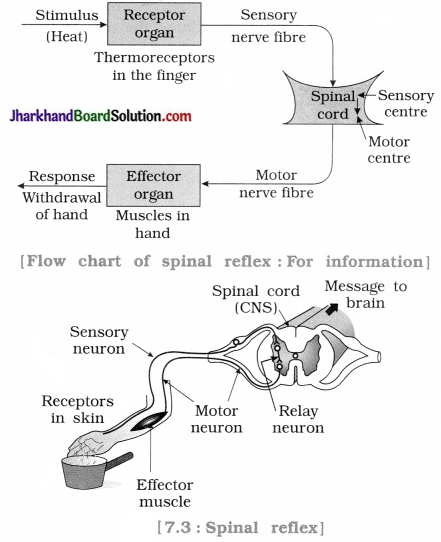
Thus a neural pathway for the sensory and motor messages that pass through the spinal cord forms the reflex arc. A very rapid response is shown through it.
The following example can clarify the meaning of reflex arc:
Suppose by mistake and unknowingly one touches a hot object by one’s hand. One would withdraw the hand all of a sudden without giving a slightest thought. Here the hot object is the source of stimulus.
This stimulus activates the sensory nerve fibre in the hand and carry that impulse to the spinal cord. The sensory centres in the spinal cord receive the stimulus and transmits the response to the motor centre of the spinal cord. This motor message is transmitted through the motor nerve fibre to definite muscles of the hand, which upon contraction, withdraws the hand. The hand or its muscles act as effector organ. This entire neural path from the sensory or receptor organ, to the effector organ is a reflex arc.
(10) Synapse
Answer:
In the arrangement of two consecutive neurons the axon fibre endings of one neuron and s the dendrite endings of the next neuron having a microscopic gap is called synapse.
Question 3.
Fill in the blanks :
- The plants coordinate their behaviour against the environmental changes by using ………………..
- The responses of plants are not rapid for want of ………………..
- ……………….. is a growth-inhibitor hormone of plants.
- The stem exhibits ……………….. geotropism and ……………….. phototropism.
- The tendrils of pea plants are the example of ………………..
- The olfactory receptors will detect ………………..
- ……………….. have evolved in animals as efficient ways of functioning in the absence of true thought processes.
- ……………….. part of brain for learning process and part of brain responsible for memory.
- The cells of sensitive plant change shape by changing the ……………….. in them resulting in swelling or shrinking.
- Cytokinins promotes ……………….. in plants.
- ……………….. hormone has the target organ heart.
- The timing and amount of animal hormone released are regulated by …………………
Answer:
- hormones
- nervous system
- Abscisic acid
- negative, positive
- thigmotropism
- smell
- Reflex arc
- Cerebellum, cerebrum
- amount of water
- cell division
- Adrenaline
- feedback mechanism
![]()
Question 4.
State whether the following statements are true or false:
- Many involuntary actions are controlled by the mid-brain and hind-brain.
- Brain is never involved in reflex action.
- The communication between the peripheral nervous system and the other parts of the body is facilitated by the central nervous system.
- Neuromuscular junction is synapse like gap between nerve ending and muscle fibre.
- When we have cold, efficiency of olfactory receptors reduces.
- Nerve cells have special proteins that change their shape and arrangement for conduction of impulse.
- Touch-me-not, a sensitive plant is of the Mimosa family.
- The movement of sunflowers in response to day or night is quite fast.
- The sensitive plants detect the touch though there is no nervous tissue or any muscle tissue.
- Gibberellin gives signal to plant to stop the growth.
- Hypothalamus plays an important role in the release of many hormones from pituitary gland.
- Chemical coordination is seen in both plants and animals.
Answer:
- True
- False
- False
- True
- True
- False
- True
- False
- True
- False
- True
- True
Question 5.
Match the following:
(1)
| Column I | Column II |
| 1. Fore-brain | a. Balance of body |
| 2. Medulla | b. Reflex arc |
| 3. Cerebellum | c. Main thinking part |
| 4. Spinal cord | d. Salivation |
Answer:
(1 → c), (2 → d), (3 → a), (4 → b).
(2)
| Column I | Column II |
| 1. Insulin | a. Testes |
| 2. Testosterone | b. Pancreas |
| 3. Growth hormone | c. Ovaries |
| 4. Estrogen | d. Pituitary |
Answer:
(1 → b), (2 → a), (3 → d), (4 → c).
(3)
| Column I | Column II |
| 1. Auxin | a. Wilting of leaves |
| 2. Gibber ellin | b. Promotes cell-division |
| 3. Cytokinin | c. Helps in stem-growth |
| 4. Abscisic acid | d. Phototropism |
Answer:
(1 → d), (2 → c), (3 → b), (4 → a).
(4)
| Column I | Column II |
| 1. Adrenaline | a. Regulates blood sugar level |
| 2. Thyroxin | b. Increases breathing, heart beats. |
| 3. Insulin | c. Regulates menstrual cycle. |
| 4. Estrogen | d. Regulates metabolism for body growth. |
Answer:
(1 → b), (2 → d), (3 → a), (4 → c).
Question 6.
Chart-diagram based questions:
1. Which of the following diagram is correct? Why?
Answer:

Diagram (a) is correct, because roots show positive geotropism and stem shows negative geotropism.
2. Label (a), (b), (c) and (d) in the given figure showing the pathway of thermal impulse.

Answer:
(a) Sensory neuron
(b) Relay neuron
(c) Motor neuron
(d) Effector = muscle in skin
3. Identify (a), (b), (c) and (d) in the given figure. Give one name of the hormone secreted I; from each of any two of them.

Answer:
(a) Pineal gland – Melatonin hormone
(b) Pituitary gland – Growth hormone
(c) Thyroid gland – Thyroxine
(d) Thymus gland – Thymocine
4. A graph shows change after a lunch of a healthy individual whose diet is rich in sweets.
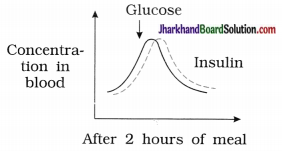
What you explain from it?
Answer:
When the sugar level rises in blood, pancreas releases more insulin to regulate blood sugar level. As blood sugar level falls, insulin secretion is reduced by feedback mechanism.
Question 7.
Select the correct alternative from those given below each question:
1. The roots of a plant are ………………..
A. positive phototropic, but negative geotropic
B. negative geotropic, but negative phototropic
C. negative phototropic, but positive hydrotropic
D. negative hydrotropic, but positive phototropic
Answer:
C. negative phototropic, but positive hydrotropic
2. The diagram shows a plant which has received light from one side only. Which characteristics are shown by the plant?

A. Excretion and growth
B. Response and reproduction
C. Growth and response
D. Reproduction and nutrition
Answer:
C. Growth and response
3. The growth of a pollen tube towards the ovule is caused by
A. phototropism
B. hydrotropism
C. geotropism
D. chemotropism
Answer:
D. chemotropism
4. For the synthesis of which of the following hormone is iodine necessary?
A. Adrenaline
B. Auxin
C. Thyroxin
D. Insulin
Answer:
C. Thyroxin
5. Which of the following hormone prepares our body for action in emergency situations?
A. Testosterone
B. Growth hormone
C. Adrenaline
D. Insulin
Answer:
C. Adrenaline
![]()
6. Which is male sex hormone?
A. Estrogen
B. Adrenaline
C. Testosterone
D. Progesterone
Answer:
C. Testosterone
7. Which of the following endocrine gland does not occur as a pair in the human body?
A. Adrenal
B. Pituitary
C. Testis
D. Ovary
Answer:
B. Pituitary
8. Which of the following helps in maintaining posture and balance of the human body?
A. Cerebrum
B. Cerebellum
C. Medulla
D. Pons
Answer:
B. Cerebellum
9. Which of the following plant shows immediate response to touch by its leaves?
A. Sunflower
B. Pea
C. Mimosa
D. None of the given
Answer:
C. Mimosa
10. By whom are the continuous heartbeats controlled?
OR
Where are the regulatory centres for the blood pressure located?
A. Cerebrum
B. Cerebellum
C. Mid-brain
D. Medulla
Answer:
D. Medulla
11. Which of the following plant hormone helps in the growth of the stem?
A. Auxin
B. Gibberellin
C. Cytokinin
D. Abscisic acid
Answer:
A. Auxin, Gibberellin
12. Through whom does the impulse enter into the cyton?
A. Dendrite
B. Axons
C. Both A and B
D. None of the given
Answer:
A. Dendrite
13. Which is the largest and the most complex part of the human brain?
A. Medulla
B. Cerebellum
C. Hypothalamus
D. Cerebrum
Answer:
B. Cerebellum
14. Who regulates the involuntary reflexes such as coughing, sneezing, hickup, vomiting, etc.?
A. Medulla
B. Cerebellum
C. Hypothalamus
D. Cerebrum
Answer:
A. Medulla
15. The deficiency of which hormone causes diabetes?
A. Estrogen
B. Thyroxin
C. Adrenaline
D. Insulin
Answer:
D. Insulin
16. Where is the arrangement in the body for i reflex action?
A. In medulla oblongata
B. In spinal cord
C. In pons
D. In heart
Answer:
B. In spinal cord
17. What is the main function of endocrine system in animals?
A. Coordination
B. Combination
C. Regulatory
D. None of the given
Answer:
A. Coordination
18. Which ovarian hormone regulates menstrual cycle in women?
A. Testosteron
B. Estrogen
C. Thyroxin
D. None of these
Answer:
B. Estrogen
19. Which gland is stimulated to release its <; secretion in a scary situation in squirrels?
A. Adrenal
B. Pituitary
C. Thyroid
D. Hypothalamus
Answer:
A. Adrenal
20. “Withdrawal of hand when unknowingly rose prickle pricks the hand”, which is this process?
A. Autonomous reaction
B. Reflex action
C. Thigmotropism
D. None of the given
Answer:
B. Reflex action
21. Hypothalamus is a part of ……………..
A. Fore-brain
B. Spinal cord
C. Muscle tissue
D. Cerebellum
Answer:
A. Fore-brain
22. Who secretes releasing hormones?
A. Pituitary gland
B. Hypothalamus
C. Autonomous Nervous System
D. Thalamus
Answer:
B. Hypothalamus
23. Whose excessive secretion causes the body to look like a gorilla?
A. Thyroxin
B. Growth hormone
C. Adrenaline
D. All of the given
Answer:
B. Growth hormone
24. Which disease takes place when there is a increase of sugar in the blood and in the mine?
A. Dwarfism
B. Goitre
C. Diabetes
D. Both A and B
Answer:
C. Diabetes
25. Statement A: Adrenaline diverts the blood to skeletal muscles of squirrel.
Reason R: Squirrel relies not only on electrical impulses but also on chemical signals.
Which option is correct for Statement A and Reason R?
A. Both A and R are correct and R is explanation of A.
B. Both A and R are correct, but R is not explanation of A.
C. A is correct, R is incorrect.
D. A is incorrect, R is correct.
Answer:
B. Both A and R are correct, but R is not explanation of A.
26. Statement A: The fore-brain is the main thinking part of the brain.
Reason R: Thinking is a complex activity that S involves a complicated interaction? of many nerve impulses.
Which option is correct for Statement A and i Reason R?
A. Both A and R are correct and R is explanation of A.?
B. Both A and R are correct, but R is not explanation of A.
C. A is correct, R is incorrect.
D. A is incorrect, R is correct.
Answer:
A. Both A and R are correct and R is explanation of A.?
27. Statement A: Auxin helps the cells to grow longer and plant appears to bend s towards light.
Reason R: Auxin diffuses towards shady side s of shoot from its tip.
Which option is correct for Statement A and Reason R?
A. Both A and R are correct and R is explanation of A.
B. Both A and R are correct, but R is not? explanation of A.
C. A is correct, R is incorrect.
D. A is incorrect, R is correct.
Answer:
A. Both A and R are correct and R is explanation of A.
![]()
28. How many endocrine glands from following are not in pairs?
Pancreas, adrenal, thyroid, testes, pituitary?
A. 2
B. 3
C. 4
D. 5
Answer:
B. 3
29. Find incorrect statement for cerebrum.?
A. It receives sensory impulses from various receptors.
B. It has areas where information stored.
C. It passes information to motor areas which control the movement of voluntary muscles.?
D. It maintains posture and balance of the body.
Answer:
D. It maintains posture and balance of the body.
30. Which is sensitive to touch?
A. Human skin
B. Tendrils of pea
C. Leaves of mimosa
D. Flowers of Sunflower?
Answer:
A. Human skin, Tendrils of pea, Leaves of mimosa
Question 8.
Answer as directed : (Miscellaneous)
(1) What is full form of CNS?
Answer:
CNS – Central Nervous System
(2) Give the correct sequence of conduction of impulse.
Answer:
Correct sequence of conduction of impulse : Dendrite → cell body → axon → nerve ending → synapse → dendrite
(3) Trace the sequence of events which occur when a bright light is focused on your eyes?
Answer:
Stimulus (bright light) → photo receptors of eyes
↓
pupil ← motor ← mid – ← sensory nerves constrict nerve brain /neurons (neuron)
(4) Find mismatched pair :
(i) Iodine – Functioning of thyroid gland
(ii) Insulin – Regulates blood sugar level
(iii) Hypothalamus – Regulates the secretion of pituitary
(iv) Estrogen-Obstructs menstrual cycle
Answer:
(iv) Estrogen-Obstructs menstrual cycle
(5) Identify me : I am a hormone generally for an emergency, increases breathing rate but reduce blood flow to digestive system and skin.
Answer:
Adrenaline
(6) State the correct sequence of impulse for spinal reflex.
Answer:
Receptors in skin → sensory neuron → spinal cord motor neuron effector (muscles)
(7) Who am I? I am present in greater concentration areas of rapid cell division, such as in fruits and seeds.
Answer:
Cytokinin
(8 ) Movement dependent on growth : Tendrils of pea :: Movement independent of growth : ………………
Answer:
Drooping of leaves of chhui-mui
(9) Which event is indicated in the diagram? Which hormone is responsible for it?
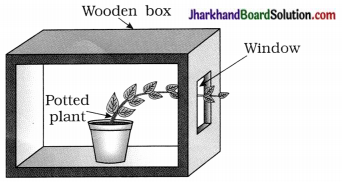
Answer:
Positive phototropism in shoot is indicated in the diagram. Auxin is responsible for it.
(10) Deficiency of growth hormone: ……………… ::
Deficiency of ……………… : diabetes
Answer:
Dwarfism, Insulin
(11) Identify me : I am controlling your daily activities such as walking, riding a bicycle, picking up object, etc.
Answer:
Cerebellum
(12) Find mismatched pair:
(i) Growth related movement – slower
(ii) Movement in sunflower in response to day or night – quite slow
(iii) Movement of our leg-very slow
Answer:
(iii) Movement of our leg-very slow
(13) Give the scientific terms used to represent the following:
(i) Bending of a shoot towards light
Answer:
Phototropism
(ii) Growing of roots towards the earth
Answer:
Geotropism
(iii) Growing of a pollen tube towards ovule
Answer:
Chemotropism
(iv) Bending of roots towards water
Answer:
Hydrotropism
(v) Winding of tendril around a support
Answer:
Thigmotropism
(14) Bony box : Brain
……………… : Spinal cord
Answer:
Backbone (vertebral column)
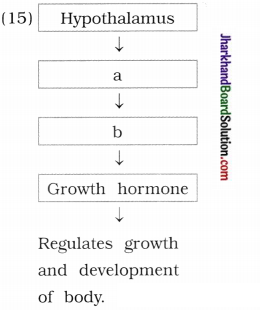
Fill a and b to make the correct sequence.
Answer:
a – growth hormone releasing factor
b – pituitary gland
Value Based Questions With Answers
Question 1.
You saw a tragic road accident resulting in death of two persons. The reason for that is bike rider tried to overtake the truck from wrong-side with overspeed. He was not wearing a helmet that caused head injury.
You were scared because you also have same habit to drive activa without wearing helmet. Your father often warned you that to drive vehicle without a driving licence is a crime.
Questions :
- Which part of brain is involved into learning how to drive vehicle?
- Injury to which part of brain leads to instant death of an individual? Why?
- Which gland became more active when you saw the accident? Which hormone was poured in blood? What changes did you feel in body?
Answer:
- Cerebrum and Cerebellum
- Medulla oblongata. Because all involuntary activities are controlled by it. Injury to that part disturbs all involuntary functions and leads to instant death.
- Adrenal gland became more active. Adrenaline s hormone was poured in blood. Perspiration, increased heartbeats and breathing rate, etc. were the changes felt in the body.
Question 2.
Your father-mother are in a age-group at forty plus. On their routine blood test, some disturbance in their blood tests were reported, s Your family doctor advised your father to walk? regularly and consume a diet containing low s sugar. Doctor insisted your mother to take 25 mg elthroxine tablet daily.
Questions:
- From your study, what do you think about s the report of the blood test of your father?
- Which gland is not functioning properly and which hormone is not secreted in s appropriate amount in your father’s body?
- Which gland is affected in your mother’s? body?
- Why elthroxine tablet is suggested by the S doctor?
Answer:
- Blood sugar level may be more than the normal level in the blood of father.
- Pancreas, insulin
- Thyroid gland
- Elthroxine is a synthetic thyroxine. It fulfills? the deficiency of thyroxine.
Question 3.
You were visiting your friend’s house. You observed some indoor plants in drawing room. You noticed that shoots of all plants slightly moved towards open window. Aunty told you that she had often changed the position of s the arrangement of plants. But in any position shoots of plants showed same behaviour.
Questions:
- Which movements are shown by plants?
- Which hormone is responsible for such movement in plant?
- How such hormone is functioning in plant body?
- Which arrangement do you suggest for plants to show straight growth of shoot?
Answer:
- Phototropism
- Auxin
- Auxin is synthesised at shoot tip and it diffuses towards shady side of the shoot. It stimulates the cells to grow longer on the side of the shoot which is away from light.
- Generally plants that are arranged in open area where they get direct sunlight, may grow straight shoots.
Question 4.
Note five different situations you have experienced in which your adrenal gland had become overactive and had given you a ‘fight or rim away’ response.
The situations in which your adrenal gland had become overactive and had given a ‘fight or run away’ response.
(1) While driving an autovehicle without having a license, the police attempted to stop your vehicle and you increased your speed in an attempt to run away.
(2) Your classteacher caught you telling lie, even though you had not done your homework assigned.
(3) At the annual examination of Std. IX, you felt that the question paper of Science and Technology set at the examination was tough and you were afraid in the examination hall and started perspiring profusely.
(4) You went to see movie in the cinema hall by bunking the school. School authority informed about your absence in the classroom, to your parents. You tried to tell a lie at home and you were caught.
(5) In the World Cup Cricket final match Sehwag and Sachin were out with very low scores and you became tense, thinking that this prestigeous match will be lost.
[Note : In the conditions of stress or fear, there is somewhat over secretion of adrenaline from the adrenal glands.]
Practical Skill Based Questions With Answers
Question 1.
Four different students of your class observed network of neurons in a slide under microscope. They drew a diagram of synaptic junction.
From your knowledge.
Questions:
- Which of the following figures shows the correct pathway for the conduction of impulse?
- What is synaptic junction?
- Which other junction do you know that is some what similar to synapse?
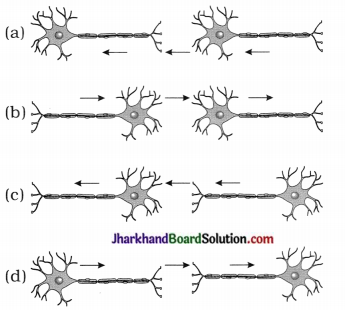
Answer:
- Diagram (c) shows correct pathway for the conduction of impulse.
- A microscopic gap between nerve ending of axon of a neuron and dendrites of next neuron is called synaptic junction.
- Neuromuscular junction.
Question 2.
Your subject teacher arranged a potted plant as shown in figure (a). Next day turn its position horizontally as shown in figure (b). After few days, you observed the plant as shown in figure (c).
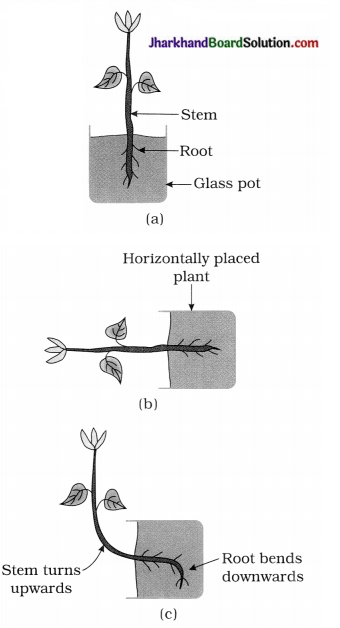
Questions :
- State the direction of growth of root and stem in the plant.
- What happens when the pot along with the plant is placed as in fig. (b)?
- Why the growth of the entire plant as shown in fig. (b) does not occur parallel to the soil surface?
- Which type of movement does this experiment explain?
Answer:
- The growth of root is negative phototropic and positive geotropic. The growth of stem is positive phototropic.
- When the plant was placed as in fig. (b). both stem and root were initially horizontal.
- The entire plant growth does not occur parallel to the soil surface because stem grows towards light and away from gravity.
- This experiment explains tropic movements due to growth in plant.
Question 3.
Observe figs, (a), (b). (c) and (d).
- Determine on the basis of your observations whether the movement occurring in the plant is growth based or not?
- State the type of movement occurred herein.
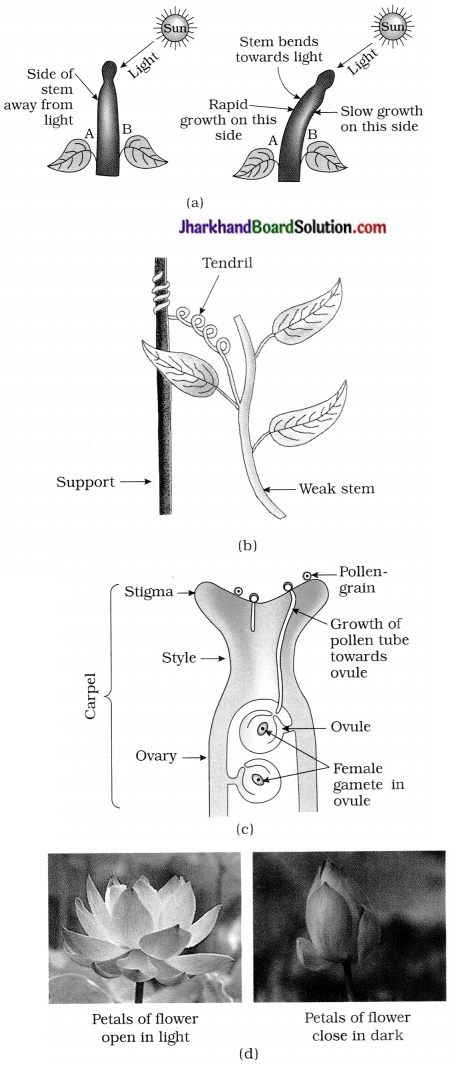
Answer:
In figures (a), (b) and (c) the movements are’ growth related and in fig. (d) the movement is not related to growth.
Memory Map:
